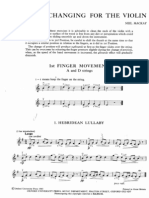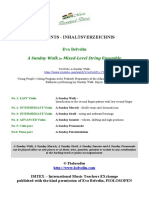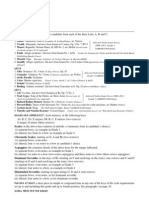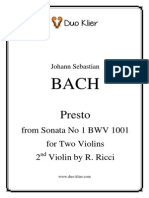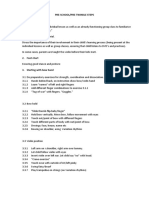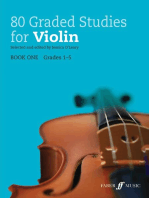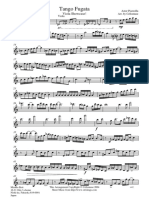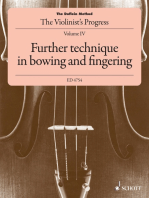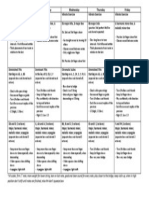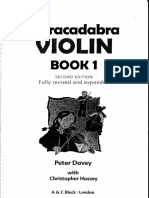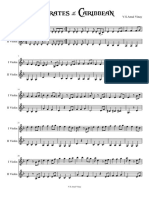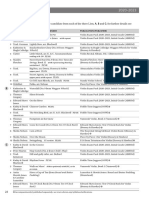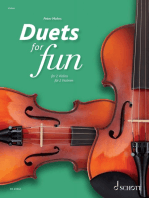Professional Documents
Culture Documents
Position Quint Etudes by Suzuki
Position Quint Etudes by Suzuki
Uploaded by
joao0%(2)0% found this document useful (2 votes)
1K views1 pageThe document discusses Dr. Suzuki's Position and Quint Etudes volumes, which were designed to build left hand technique, intonation, and shifting to complement the repertoire in Volumes 2-6. It explains that the exercises address topics like hand shaping, fourth finger strength, ear training, shifting, fingering patterns, and more. The session will demonstrate how exercises from these volumes relate to the corresponding repertoire and provide an outline for studying the exercises in a logical sequence aligned with the volumes. The goals are to introduce teachers to these resources and show how the exercises can enhance learning when integrated into lessons in a structured way.
Original Description:
explanetions
Original Title
Position Quint Etudes By Suzuki
Copyright
© © All Rights Reserved
Available Formats
DOCX, PDF, TXT or read online from Scribd
Share this document
Did you find this document useful?
Is this content inappropriate?
Report this DocumentThe document discusses Dr. Suzuki's Position and Quint Etudes volumes, which were designed to build left hand technique, intonation, and shifting to complement the repertoire in Volumes 2-6. It explains that the exercises address topics like hand shaping, fourth finger strength, ear training, shifting, fingering patterns, and more. The session will demonstrate how exercises from these volumes relate to the corresponding repertoire and provide an outline for studying the exercises in a logical sequence aligned with the volumes. The goals are to introduce teachers to these resources and show how the exercises can enhance learning when integrated into lessons in a structured way.
Copyright:
© All Rights Reserved
Available Formats
Download as DOCX, PDF, TXT or read online from Scribd
Download as docx, pdf, or txt
0%(2)0% found this document useful (2 votes)
1K views1 pagePosition Quint Etudes by Suzuki
Position Quint Etudes by Suzuki
Uploaded by
joaoThe document discusses Dr. Suzuki's Position and Quint Etudes volumes, which were designed to build left hand technique, intonation, and shifting to complement the repertoire in Volumes 2-6. It explains that the exercises address topics like hand shaping, fourth finger strength, ear training, shifting, fingering patterns, and more. The session will demonstrate how exercises from these volumes relate to the corresponding repertoire and provide an outline for studying the exercises in a logical sequence aligned with the volumes. The goals are to introduce teachers to these resources and show how the exercises can enhance learning when integrated into lessons in a structured way.
Copyright:
© All Rights Reserved
Available Formats
Download as DOCX, PDF, TXT or read online from Scribd
Download as docx, pdf, or txt
You are on page 1of 1
The Position and Quint Etudes: Dr.
Suzukis Plan for Building Left Hand
Technique, Intonation and Shifting - and How to Use Them!
Dr. Suzukis volumes Position Etudes and Quint Etudes were written and designed for
students and teachers expressly as corollary technical material to be studied in conjunction with
Volumes 2 - 6. The exercises run the gamut from basic shaping of the left hand, developing
strength in the fourth finger, ear training for intonation using resonant tones, exercises in shifting
and securing intonation and finger patterns within the positions, to the concept of guide fingers,
training intervals across the strings, shifting and balance with the front of the hand, and the
development of double stops and chords. This session will take examples from each of these
volumes to show how these exercises relate to the corresponding repertoire throughout Volumes
2 - 6. Additionally we will explore an outline and sequence for the exercises as they relate to the
volumes to facilitate building a logical pattern for study and use in lessons and home practice.
This is planned as an active session with instruments both to introduce these volumes to teachers
not familiar with this material or not clear how to integrate its use into their lesson; and to serve
as a refresher and stimulate further exploration by experienced teachers of this often
underutilized but valuable resource.
Goals and Target Audience:
The goals of this session are to introduce these volumes to teachers not familiar with them and
show how Dr. Suzuki designed the development of technique for students not just through the
repertoire but also through these specific exercises to enhance and support the learning. The
second goal of this session is to show how these exercises can be used in a logical sequence
throughout the repertoire, as that is not readily apparent in their current layout. The target
audience is violin teachers, students and their parents.
You might also like
- The Violin in 5ths: Developing Intonation and SoundFrom EverandThe Violin in 5ths: Developing Intonation and SoundRating: 4.5 out of 5 stars4.5/5 (8)
- Mackay PositionchangingDocument12 pagesMackay PositionchangingBruno Barbosa100% (1)
- Belvelin Sunday WalkDocument7 pagesBelvelin Sunday WalkCarolineLutzNo ratings yet
- The Doflein Method: The Violinist's Progress. Development of technique within the first positionFrom EverandThe Doflein Method: The Violinist's Progress. Development of technique within the first positionRating: 5 out of 5 stars5/5 (2)
- Balance Point EssayDocument8 pagesBalance Point EssayHarry Fisher Grossman0% (1)
- The Doflein Method: The Violinist's Progress. The BeginningFrom EverandThe Doflein Method: The Violinist's Progress. The BeginningRating: 5 out of 5 stars5/5 (4)
- The Doflein Method: The Violinist's Progress. The second and third positionsFrom EverandThe Doflein Method: The Violinist's Progress. The second and third positionsRating: 3.5 out of 5 stars3.5/5 (5)
- Fun With Solos::: Your Favorite SiteDocument1 pageFun With Solos::: Your Favorite SiteSteven NarvaezNo ratings yet
- Violin Syllabus Grade 5 ABRSMDocument1 pageViolin Syllabus Grade 5 ABRSMmintambrosiaNo ratings yet
- Little Fugue Two ViolinsDocument2 pagesLittle Fugue Two Violinsdrosenthal3No ratings yet
- Bach - Presto For Two ViolinsDocument16 pagesBach - Presto For Two ViolinsCoporlas100% (3)
- Haydn Concerto in G Major PDFDocument29 pagesHaydn Concerto in G Major PDFLoredana VinciNo ratings yet
- Tango EightDocument4 pagesTango EightFeras SpearsNo ratings yet
- Violin0512 - Grade 5 SyllabusDocument2 pagesViolin0512 - Grade 5 SyllabusVincent CupidoNo ratings yet
- Gypsy CapriceDocument6 pagesGypsy CapriceMichał Bielenia50% (2)
- StringtunesViola - Sheila Nelson PDFDocument15 pagesStringtunesViola - Sheila Nelson PDFRicardoNo ratings yet
- String Crossing Exercises - ViolinDocument1 pageString Crossing Exercises - ViolinRafael VideiraNo ratings yet
- PRE-SCHOOL Pre-Twinkle StepsDocument1 pagePRE-SCHOOL Pre-Twinkle StepsMichaela Peanut-Butter Van BlerkNo ratings yet
- IMSLP623315-PMLP1001198-Eleven Miniature Studies For Violin Solo CompleteDocument15 pagesIMSLP623315-PMLP1001198-Eleven Miniature Studies For Violin Solo CompletegabroarellosNo ratings yet
- Lista de RepertórioDocument23 pagesLista de RepertórioMila ChaubahNo ratings yet
- Vdocuments - MX - Ivan Galamian Scales For Violin PDFDocument168 pagesVdocuments - MX - Ivan Galamian Scales For Violin PDFGERAR ULI GERAR100% (1)
- New Viola Sight-Reading Tests For 2012 - A Preview: Grade 1Document4 pagesNew Viola Sight-Reading Tests For 2012 - A Preview: Grade 1Gustavo Villamizar Diaz100% (1)
- Tango Fugata : Violin I Viola Showcase!Document2 pagesTango Fugata : Violin I Viola Showcase!Rodrigo PozoNo ratings yet
- Strum Bowing Etudes--Violin: Etude Companion to the Strum Bowing Method-How to Groove on StringsFrom EverandStrum Bowing Etudes--Violin: Etude Companion to the Strum Bowing Method-How to Groove on StringsNo ratings yet
- Violin Method Book 5: Sixth and Seventh PositionsDocument89 pagesViolin Method Book 5: Sixth and Seventh PositionsTamara Obando LumanNo ratings yet
- Edoc - Pub - Jazz Violin Method PDFDocument75 pagesEdoc - Pub - Jazz Violin Method PDFNyein San HlaNo ratings yet
- Nikolic Concertino in G Major PDFDocument5 pagesNikolic Concertino in G Major PDFJuan Miquel Pons VallesNo ratings yet
- Kreutzer: 42 Etudes, 2 Violin by Fr. HermannDocument36 pagesKreutzer: 42 Etudes, 2 Violin by Fr. HermanndziurawekaloszeNo ratings yet
- Piazzola - Violin IDocument2 pagesPiazzola - Violin ICarlos Alberto Fernández FalenNo ratings yet
- Fischer The Violin LessonDocument4 pagesFischer The Violin LessonOktavianna PanjaitanNo ratings yet
- Dancla Six Airs Varies ScoreDocument34 pagesDancla Six Airs Varies ScoreSaida Sadigova100% (2)
- The Doflein Method: The Violinist's Progress. Further technique in bowing and fingering chiefly in the first positionFrom EverandThe Doflein Method: The Violinist's Progress. Further technique in bowing and fingering chiefly in the first positionRating: 5 out of 5 stars5/5 (3)
- Sheila M.nelsonDocument4 pagesSheila M.nelsonPilar Véliz PedroNo ratings yet
- Violin RepertoireDocument5 pagesViolin RepertoireGiacomoNo ratings yet
- Solos For Young Violinist Vol. 2 - PianoDocument54 pagesSolos For Young Violinist Vol. 2 - Pianoviola.musica86100% (1)
- Bach Concerto in A Minor PDFDocument29 pagesBach Concerto in A Minor PDFsimon100% (1)
- Grade 8 Violin Scales Practice SheetDocument1 pageGrade 8 Violin Scales Practice Sheetjewellynnz100% (1)
- Abracadabra Violin PRA DASARDocument42 pagesAbracadabra Violin PRA DASARACIEM ElkemlyNo ratings yet
- Twenty Duets F0R Violins: Hasan Hüseyin YILMAZDocument36 pagesTwenty Duets F0R Violins: Hasan Hüseyin YILMAZmehrdad.makaremNo ratings yet
- Maia Bang Book 1Document98 pagesMaia Bang Book 1Anonymous t5aOqdHpuh100% (4)
- He Is A Pirate Pirates of The Caribbean Theme by V S Amal VinayDocument2 pagesHe Is A Pirate Pirates of The Caribbean Theme by V S Amal VinayV.S.Amal VinayNo ratings yet
- Applebaum ExercisesDocument11 pagesApplebaum ExercisesMJ MagnoNo ratings yet
- Violin Complete 2012Document11 pagesViolin Complete 2012Jomon JosephNo ratings yet
- Vdocuments - MX - Nikolic Concertino For Violin Piano and Violin PDFDocument5 pagesVdocuments - MX - Nikolic Concertino For Violin Piano and Violin PDFKristina FaleNo ratings yet
- J. H. Fiocco. Allegro PDFDocument11 pagesJ. H. Fiocco. Allegro PDFjmrubiap100% (1)
- Violin Initial 2020 Rev Sep 2020Document18 pagesViolin Initial 2020 Rev Sep 2020Wael Trabelsi100% (1)
- Vieuxtemps - Fantaisie-Caprice Op.11 For Two ViolinsDocument25 pagesVieuxtemps - Fantaisie-Caprice Op.11 For Two ViolinsCoporlas100% (2)
- De Beriot: Violin Concerto No 9 in A Minor, Op.104Document35 pagesDe Beriot: Violin Concerto No 9 in A Minor, Op.104Jonathan MartinezNo ratings yet
- Seitz Student Concerto No 5 PDFDocument18 pagesSeitz Student Concerto No 5 PDFLuis Escorcia Ramirez100% (3)
- A Performer S Guide To Violin Orchestral ExcerptsDocument126 pagesA Performer S Guide To Violin Orchestral ExcerptsRicardo Molter100% (3)
- Duets for Fun: for 2 ViolinsFrom EverandDuets for Fun: for 2 ViolinsPeter MohrsRating: 5 out of 5 stars5/5 (2)

